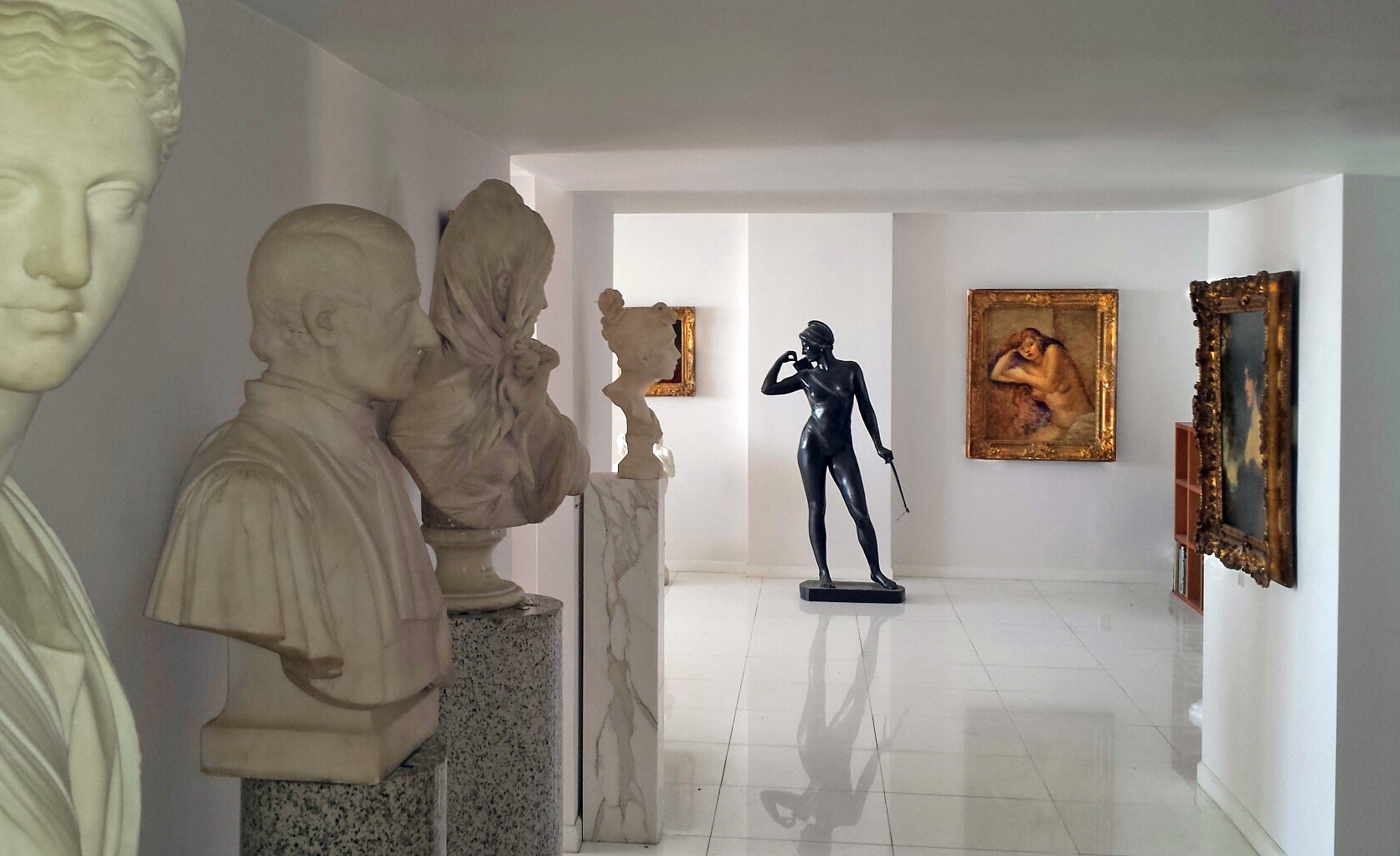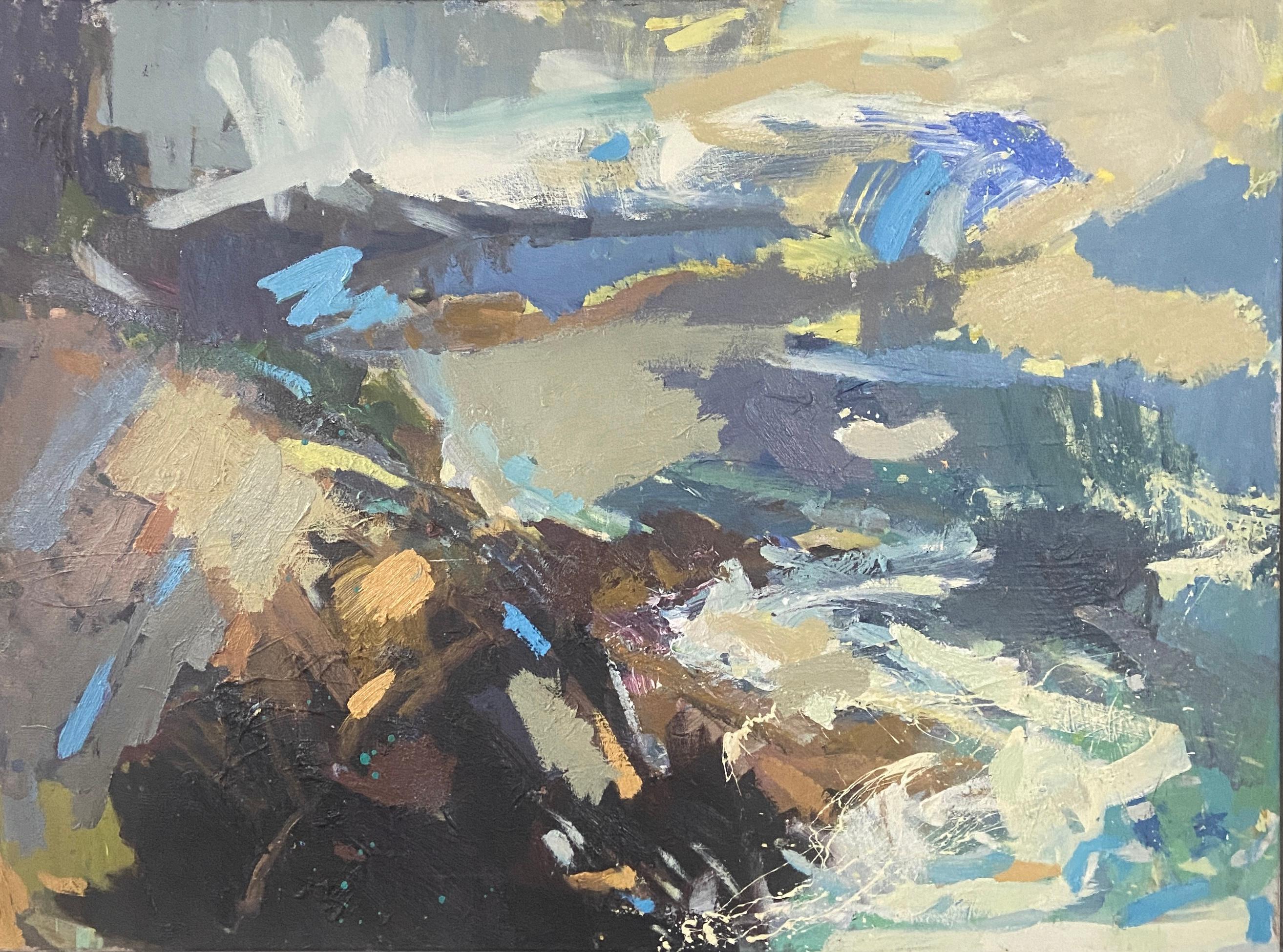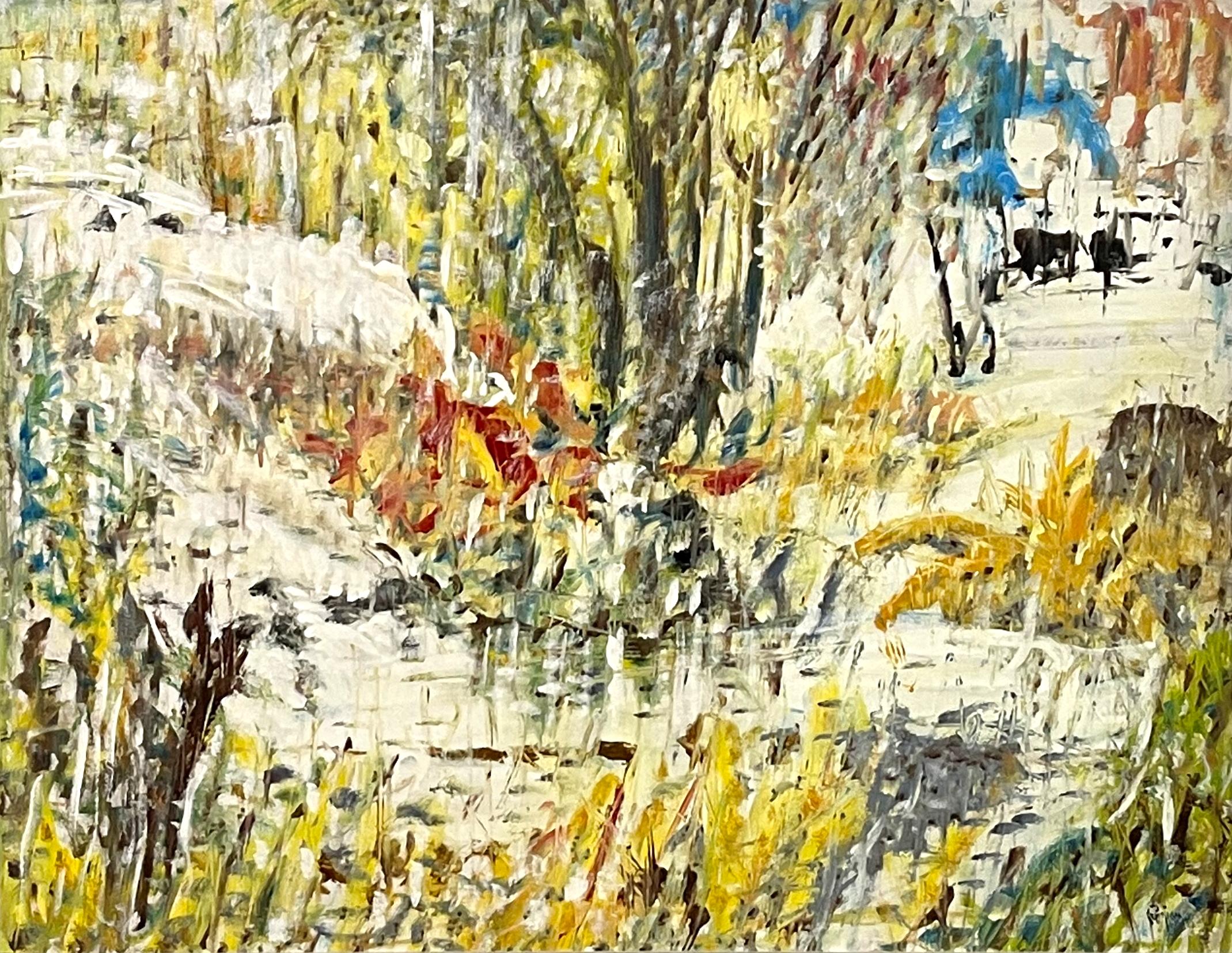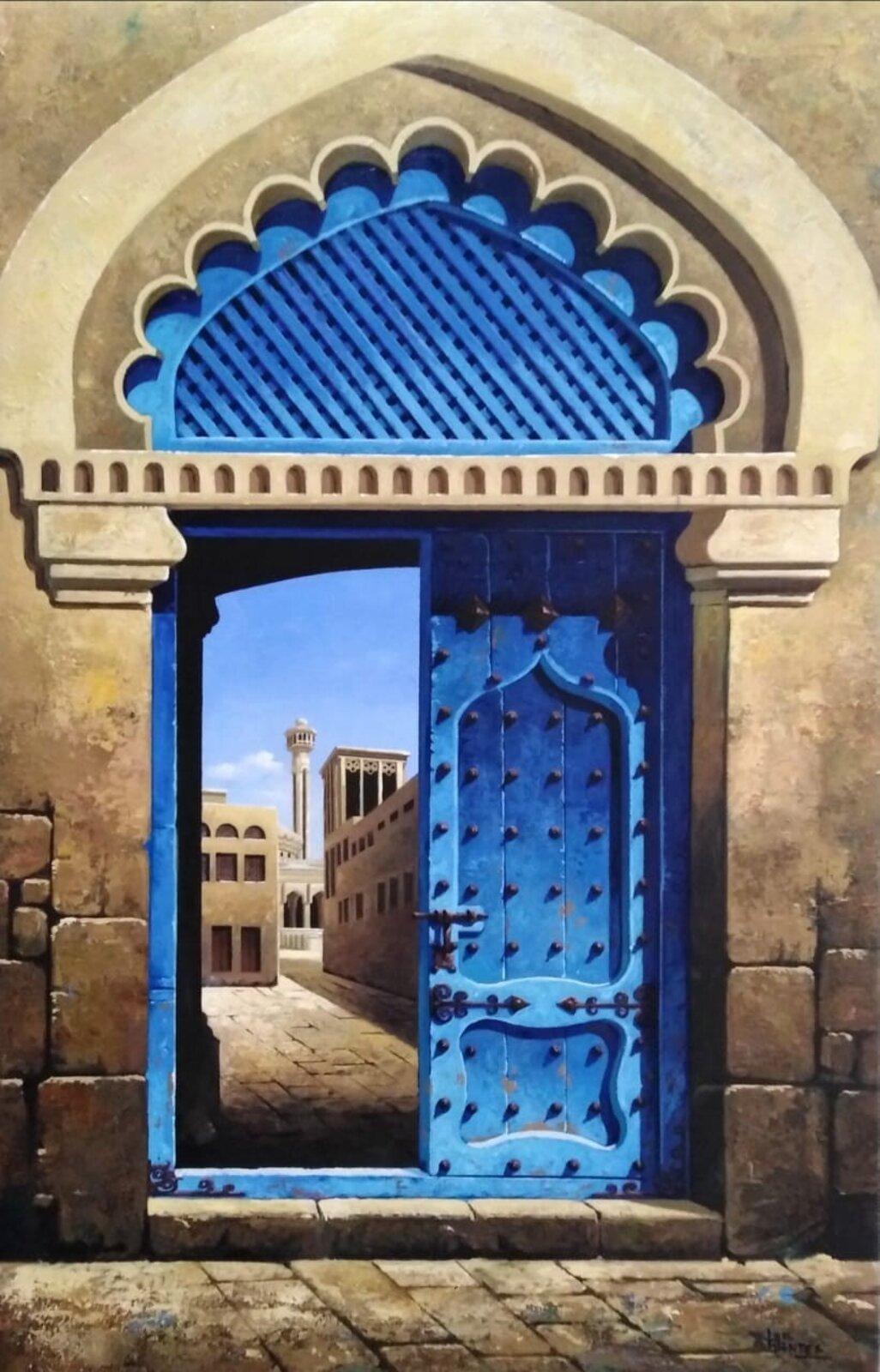Items Similar to Industrial Landscape
Want more images or videos?
Request additional images or videos from the seller
1 of 9
George LuksIndustrial Landscape1930's
1930's
About the Item
Quick and confident brush strokes describe the gritty forms of perhaps steam engines or railroad yards. Luks bravura style of putting paint to canvas anticipates action painting of the Abstract Expressionists who would follow Luks generations later. Sotheby's, New York, March 2005 Cigna Museum and Art Collection Exhibitions: Beyond the Liberty Bell, Philadelphia Art from the Cigna Museum,White Planes, New York, 10/30/1995 - 1/31/1996 Housed in a quality reproduction frame signed lower left
- Creator:George Luks (1867 - 1933, American)
- Creation Year:1930's
- Dimensions:Height: 12 in (30.48 cm)Width: 16 in (40.64 cm)
- Medium:
- Movement & Style:
- Period:
- Condition:
- Gallery Location:Miami, FL
- Reference Number:1stDibs: LU38533676202
George Luks
George Luks was an American realist painter and comic illustrator, best known for his images of New York City and its inhabitants. Born in Williamsport, Pennsylvania, Luks worked as a vaudeville performer before moving to Philadelphia to study art at the Pennsylvania Academy of the Fine Arts. He traveled through Europe, where he attended several art schools and developed a particular admiration for Diego Velázquez, Frans Hals, and Édouard Manet. Even before leaving for Europe, Luks was publishing comic illustrations in Puck and Truth, and upon his return in 1893 he accepted a job as a newspaper illustrator at the Philadelphia Press. In 1896, the Press sent him to Cuba as a special correspondent to cover the mounting tensions there. Working at the Press, Luks befriended Everett Shinn, William Glackens, John Sloan, and Robert Henri. In 1896 Luks moved to New York City and began to work as an illustrator for Joseph Pulitzer's New York World. He drew the comic strip Hogan's Alley after the strip’s originator Frederick Opper was lured away to William Randolph Hearst’s New York Journal. Though capable of picturesque urban scenes (like those that his friends Shinn and Glackens specialized in), Luks excelled as a broad comic artist, drawing single and multi-panel cartoons for newspapers and magazines, and working as a political cartoonist for the magazine Verdict. In the 1920s, Luks drew comic sketches for Vanity Fair and The New Yorker. As a painter, Luks found inspiration in New York City, often depicting the streets and denizens of the Lower East Side, subjects which gained him little favor with art critics and jurors steeped in the genteel tradition. He painted thickly, often laying his paint on the canvas with a palette knife. In 1907, the rejection of one of his canvasses from a juried exhibition at the National Academy of Design spurred the organization of a protest exhibition the following year at Macbeth Gallery. This watershed exhibition would become known as the exhibition of "The Eight" for the eight painters who collaborated to put it together. Known for his big personality and love of liquor, Luks was a vocal proponent of American painting in the early 20th century.

About the Seller
4.9
Gold Seller
These expertly vetted sellers are highly rated and consistently exceed customer expectations.
Established in 2005
1stDibs seller since 2016
102 sales on 1stDibs
Typical response time: 1 hour
- ShippingRetrieving quote...Ships From: Miami, FL
- Return PolicyA return for this item may be initiated within 3 days of delivery.
More From This SellerView All
- Storm Composition #3By Abraham RattnerLocated in Miami, FLAn early example of Abstract Expressionism executed in 1955 during the movement's heyday and it's period of peak inventiveness. However, this work is still rooted in representation. The dark area the runs along the base of the picture is the ground and to the left, right and center there are black structures that represent trees. The work is very tactile and is composed of globs of paint that grow out from the surface and form a thick impasto. Rich vibrant saturated blues, reds and oranges create optical drama. The work look better in person. frame: 29 x 39 1/2 inches , Provenance: Kennedy Galleries The Currier Gallery of Art...Category
1950s Abstract Expressionist Abstract Paintings
MaterialsOil
- Squares - Color Field Painting - like MondrianBy Robert Goodnough, 1917-2010Located in Miami, FLSquares is a bridge between Mondrian and the Hard-edge abstraction movement. Clearly, this is a very early work because the artist has not yet found his mature style. The flat squares of uneven proportion, are in a formal but off-axis vertical /horizontal grid structure. Perhaps it's the artists take on a "drunk Mondrian" where the squares stumble to align themselves. Each square shape is different in shape and color and with visible brushstrokes and light impasto. Look carefully at the gray squares. They all have a slightly different hue. The squares are all unique individuals and not a repetition To Goodnough this was his departure from his influencer. Squares show the influence of his teachers including Hans Hofman...Category
1950s Abstract Expressionist Abstract Paintings
MaterialsOil
- Landscape Abstraction - Mid-Century - Twenty Paintings in OneLocated in Miami, FLAt the height of Abstraction Expressionism, overlooked Academic Artist John Atherton created a wonderfully complex painting that embodies many of the characteristics of what was going on in Mid-Century American Art. The work is simultaneously abstract as it is representational. Like a Bento Box, it's divided into sections by dividers. On close inspection, each section stands on it's own as a beautiful mini-painting yet coalesces as part of the whole. From a distance, it is eye-pleasing, but as the view gets closer and closer, new structures and details gloriously reveal themselves. This is an important painting and not unlike the work of Joaquín Torres-García. It was done in the last year of the artist's life. Signed lower right. Canvas is relined. Framed size: 30 x 41.25. The work is best viewed with top gallery lights to bring out color. Atherton exhibited at the famous Julien Levy Gallery in New York and his fine art is mainly associated with Magic Realism. He participated in the seminal 1943 Museum of Modern Art exhibition, American Realists and Magic Realists. The Museum of Modern Art has 4 Atherton paintings in its collection. As an Illustrator, Atherton did covers for the Saturday Evening Post, Fortune and Holiday Magazine...Category
1950s Abstract Expressionist Abstract Paintings
MaterialsCanvas, Oil
- Thought Provoking Rock Quarry - Mid Century AbstractLocated in Miami, FLThis meticulously planned, designed, and executed work depicts an ultra-wide angle view of a rock quarry/mine. The viewer looks down at close-up-stylized rock formations and then out at a horizon line with rust-colored mine trestles. Atherton hints at perspective with a broken white line that is wider in the foreground and tapers to a hairline as it recedes to the background. The work was done in 1951 at the height of America's most important art movement: Abstract Expressionism. John Atherton absorbs its influences but retains elements of representation. Atherton was an in-demand commercial artist who worked for most blue-chip clients. It is possible that this was an editorial assignment for Fortune Magazine. At the same time, Atherton was also a fine artist and the work could be an expression of pure creative pursuits. The work looks better in person and one can look at it for hours and not get bored. Look carefully and you may discover a deeper meaning in this painting of precisely arranged rocks. Signed lower right. Brooklyn Museum of Art, New York, sold to benefit the acquisitions program ____________________ From Wikipedia, the free encyclopedia John Carlton Atherton (January 7, 1900 - September 16, 1952) was an American painter and magazine illustrator, writer and designer. His works form part of numerous collections, including the Museum of Modern Art,[1] Whitney Museum of American Art and the Smithsonian American Art Museum.[2][3][4] Early Years He was the son of James Chester Atherton (1868-1928) and Carrie B. Martin (1871-1909). He was born in Brainerd, Minnesota.[5] His father was Canadian born. His parents relocated from Minnesota to Washington State, with his maternal grandparents whilst he was still an infant. He attended high school in Spokane, Washington. Career During his early years he never displayed an aptitude for art; rather, his first love being nature and the activities he relished there, mainly fishing and hunting. He enlisted in 1917, serving briefly in the U.S. Navy for a year during World War I. At the end of the war, determined to get an education he worked various part-time jobs, as a sign painter and playing a banjo in a dance band to pay his enrolment fee at the College of the Pacific and The California School of Fine Arts (now the San Francisco Art Institute). Once there, he also worked in the surrounding studios developing his oil painting techniques. A first prize award of $500 at the annual exhibition of the Bohemian Club in 1929, financed his one way trip to New York City, which helped to launch his career as an artist.[6] Atherton had aspired to be a fine artist, however his first paid jobs were for commercial art firms designing advertisements for corporations such as General Motors, Shell Oil, Container Corporation of America, and Dole. However, by 1936, encouraged primarily by friends, such as Alexander Brook, an acclaimed New York realist painter, he returned to the fine arts. Atherton continued to accept numerous commissions for magazine illustrations; such as Fortune magazine, and over the years he would paint more than forty covers for The Saturday Evening Post starting with his December 1942 design, “Patient Dog.” This picture is reminiscent of his friend Norman Rockwell ‘Americana style’ and captures a poignant moment of nostalgia, where a loyal dog looks toward a wall of hunting equipment and a framed picture of his owner in military uniform. Selected One person Exhibitions Atherton accomplished his first one-man show in Manhattan in 1936. His Painting, “The Black Horse” won the $3000 fourth prize from among a pool of 14,000 entries. This painting forms part of the Metropolitan Museum of Art collection in New York.[7] Atherton achieved recognition in New York City and elsewhere during the 1930s. Having exhibited at the Julien Levy Gallery in New York,[8] his paintings began to be collected by museums; including the Museum of Modern Art[9] and the Metropolitan Museum of Art. His reputation increased with his art deco stone lithograph poster for the 1939 New York World's Fair. In 1941, his design won first place in the Museum of Modern Arts “National Defense Poster Competition”. Selected Public Collections Fleming Museum of Art, Burlington, Vermont Albright-Knox Art Gallery,[10] Buffalo, NY Art Institute of Chicago,[11] Chicago Wadsworth Atheneum,[12] Hartford, CT Brooklyn Museum of Art, New York Metropolitan Museum of Art, New York The Museum of Modern Art,[13] New York Whitney Museum of American Art,[14] New York Pennsylvania Academy of the Fine Arts,[15] Philadelphia De Young Museum,[16] San Francisco Smithsonian American Art Museum,[17] Washington DC Butler Institute of American Art[18] Youngstown, OH The Famous Artists School Founded in 1948 in Westport, Connecticut, U.S.A. The idea was conceived by members of the New York Society of Illustrators (SOI), but due to the Society's legal status, could not be operated by it. SOI member Albert Dorne led the initiative to set up a separate entity, and recruited the support of Norman Rockwell, who was also an SOI member. For the founding faculty, Dorne recruited Atherton, as well as accomplished artists such as Austin Briggs, Stevan Dohanos, Robert Fawcett, Peter Helck, Fred Ludekens, Al Parker, Norman Rockwell, Ben Stahl, Harold von Schmidt and Jon Whitcomb.[19] He collaborated with Jon Whitcomb with the book “How I Make a Picture: Lesson 1-9, Parts 1”.[20][21] Society of Illustrators Atherton as an active member from his arrival in New York. The society have owned many of his works. Ex-collection includes: Rocking Horse (ca. 1949) [22] Atherton, as his peers had many of his works framed by Henry Heydenryk Jr.[23] Personal On November 2, 1926, he married Polly “Maxine” Breese (1903-1997).[24][25] They had one daughter, Mary Atherton, born in 1932. Atherton's often chose industrial landscapes, however found himself spending considerable time in Westport, Connecticut, with an active artistic community, and it became home for him, and his family. He then moved to Arlington, Vermont.[26] Norman Rockwell enlisted Atherton in what was to be the only collaborative painting in his career.[27] He was part of a group of artists including a Norman Rockwell, Mead Schaeffer and George Hughes who established residences in Arlington.[28] Atherton and Mead Schaeffer were avid fly fishermen and they carefully chose the location for the group,[29] conveniently located near the legendary Battenkill River. In his free time, Atherton continued to enjoy fly-fishing.[30] He brought his artistic talent into the field of fishing,[31] when he wrote and illustrated the fishing classic, “The Fly and The Fish”.[32] He died in New Brunswick, Canada in 1952,[33] at the age of 52 in a drowning accident while fly-fishing.[34] Legacy The Western Connecticut State University holds an extensive archive on this artist.[35] His wife, Maxine also published a memoir “The Fly Fisher and the River” [36] She married Watson Wyckoff in 1960. Ancestry He is a direct descendant of James Atherton,[37][38] one of the First Settlers of New England; who arrived in Dorchester, Massachusetts in the 1630s. His direct ancestor, Benjamin Atherton was from Colonial Massachusetts...Category
1950s Abstract Expressionist Abstract Paintings
MaterialsMixed Media, Gouache, Board
- Snowstorm, Morningside Heights, New York City - MonochromaticLocated in Miami, FLEugene Camille Fitsch Am./Fr., 1892-1972 - Signed lower right. Framed dimensions 20 3/4" x 34 7/8" framed Provenance: Studio of the Artist to Private Collection Boston, Massachuse...Category
1940s Abstract Expressionist Landscape Paintings
MaterialsCasein
- City Scape Abstract Expressionist Composition -Jackson Pollack FriendBy Joseph MeertLocated in Miami, FLThe fame, notoriety, and monetary value of an artist's work in today's market are not based on one's talent and vision. Factors such as marketing and media momentum play a defining r...Category
1940s Abstract Expressionist Abstract Paintings
MaterialsGouache
You May Also Like
- Landscape, Abstract Expressionist Painting by Alexander M. BingLocated in Long Island City, NYA fine period Abstract Expressionist oil painting by noted American artist, Alexander M. Bing (1878 - 1959), signed 'AMB' lower right. Gallery label from ...Category
1950s Abstract Expressionist Abstract Paintings
MaterialsMasonite, Oil
- Untitled (View of Provincetown Harbor)By Hans HofmannLocated in Palm Desert, CA"Untitled (View of Provincetown Harbor)", is an oil on panel work made by Hans Hofmann circa 1937. The work is stamped verso by the estate of Hans Hofmann. The artwork size is 17 1/4...Category
Early 20th Century Abstract Expressionist Landscape Paintings
MaterialsOil, Panel
- Todi, Umbria, original 30x36 abstract expressionist Italian landscapeBy Sonia GrinevaLocated in Spring Lake, NJWhen the silver screen interconnects with Italy, it is often in Umbria's picturesque hilltop town of Todi. Boasting an abundance of medieval buildings and ancient. stone walls in th...Category
21st Century and Contemporary Abstract Expressionist Abstract Paintings
MaterialsOil
- St Ives Bay, Contemporary Expressionist Oil PaintingBy Paul WadsworthLocated in Brecon, PowysSt Ives Bay, Cornwall. England. Paul Wadsworth is one of the UK’s leading exponents of Expressionist paintings. His pieces are heavily worked with layers of richly applied paint, th...Category
2010s Abstract Expressionist Landscape Paintings
MaterialsOil
- Untitled (Abstracted Landscape)By Arthur PinajianLocated in Lawrence, NYThe Pinajian story is one of near loss, discovery and posthumous success. A compatriot of De Kooning and friend of fellow Armenian-American Gorky, Pinajian was a member of the post-...Category
1980s Abstract Expressionist Abstract Paintings
MaterialsOil
- Ancient doors-original surreal realism architecture painting-contemporary ArtBy Luis FuentesLocated in London, Chelsea"Ancient Door" by Luis Fuentes stands as a captivating original architectural painting, skillfully blending surrealism and realism to create a visual narrative that transcends time and place. Crafted in oil on canvas, this masterpiece, proudly signed by the artist, awaits its place as a distinguished piece in any art collection. Step into a world where the title, "Ancient Door," becomes a portal to a captivating realm. The carefully chosen color scheme, a harmonious interplay of blues and beige, sets the stage for an exploration of architectural wonders. The focal point of the piece is a set of ancient blue doors, gracefully open to reveal a view of Arabic architecture beyond. Fuentes' attention to detail and masterful use of color breathe life into the scene, capturing the essence of antiquity and transporting viewers to a time where craftsmanship and design coalesce in a mesmerizing display. Whether admired in person at Signet Contemporary Art in Chelsea or explored online, "Ancient Door" invites contemplation of the rich history and cultural significance embodied in architectural elements. Luis Fuentes' skillful combination of surrealism and realism transforms this painting into an immersive experience, where the ancient doors become a threshold to the enchanting beauty of Arabic architecture. Enrich your space with this evocative artwork that invites viewers to step through time and explore the allure of an "Ancient Door." Artist Biography: Luis Fuentes was born in Arequipa, Peru in 1969 to a family of artists. Luis entered university to pursue a degree in architecture and fine arts, but came to realize painting was his true vocation so he dedicated his efforts to complete his fine art training at Carlos Baca Flor School. 1991 Fuentes has received much recognition for his artistic work, including First Prize in the prestigious Peruvian National Watercolor Competition in1990.He was awarded a Diploma of Recognition in 1991 by the Peruvian National Cultural Institute for his contributions to the development of Peruvian art. Fuentes’s portfolio includes both watercolor and oils, in which he works with equal proficiency. His works of art are found in Art Galleries and private collections in the United States, Spain...Category
21st Century and Contemporary Abstract Expressionist Abstract Paintings
MaterialsCanvas, Oil
Recently Viewed
View AllMore Ways To Browse
Vintage Industrial Art
Vintage Industrial Sign
Railroad Painting
Vintage Railroad Art
1930s Industrial Painting
Railroad Oil Paintings
Railroad Vintage Signs
Steam Engine
Steam Engines
The Steam Engine
Liberty House Vintage
Liberty Bell
Liberty Bell Vintage
Railroad Bell
Vintage Railroad Bell
Mirror Lake
Antique Villa Paint
Chinese Medal





